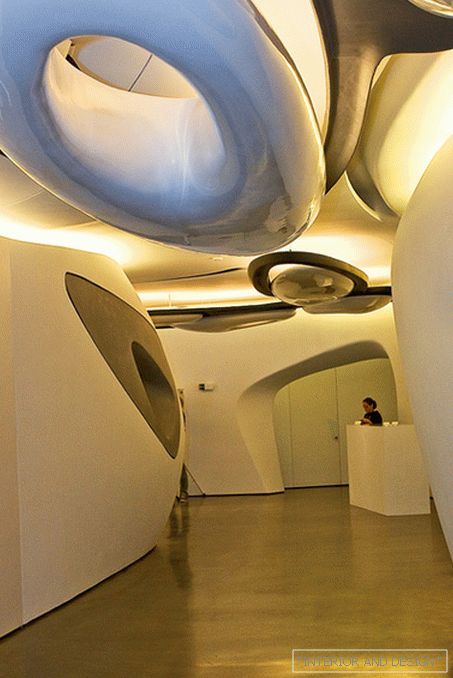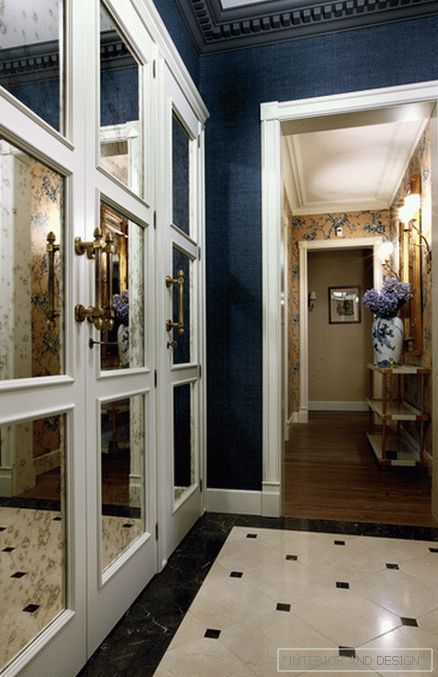November 30, 2016 in the United States opens the exhibition Design Miami - the most important event in the world of gallery and author's design. Fendi is showing The Happy Room this year. This is an exclusive collection of furniture and accessories, specially created on the occasion of the exhibition by the Italian Christina Celestino (Cristina Celestino). The Happy Room includes 12 items: a sofa and a chair upholstered in Rubelli velvet, three coffee tables with tops inlaid with onyx, marble and travertine, a dressing table and stool made of walnut, brass and marble, a five-fold screen, an outdoor mirror, a jewel box , floor lamp and hanging lamp with perforated calfskin shades. The collection is called “the first mobile VIP-room from Fendi” - in fact, it really is the same set of objects that is needed only to organize the interior in “Fendi style” without any hesitation and time.
“With its range, forms and finishes, this collection should create an atmosphere in which people simply feel calm and happy,” says its author, Christina Celestino.
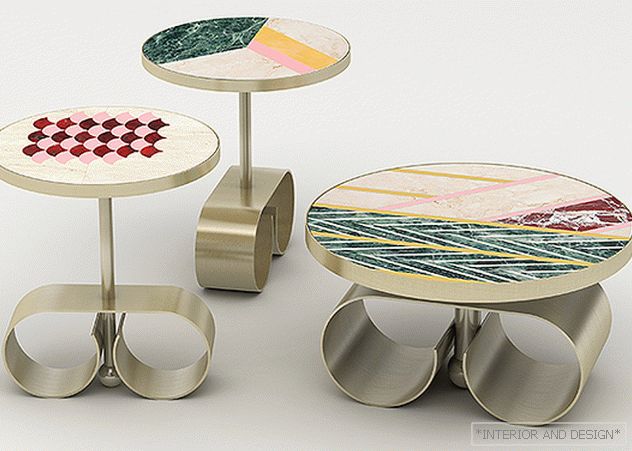 Coffee tables, call. The Happy Room. The bases are in the form of brushed brass earrings. Travertine table tops are inlaid with colored marble and onyx. The ornaments are inspired by Fendi fur inlays.
Coffee tables, call. The Happy Room. The bases are in the form of brushed brass earrings. Travertine table tops are inlaid with colored marble and onyx. The ornaments are inspired by Fendi fur inlays. 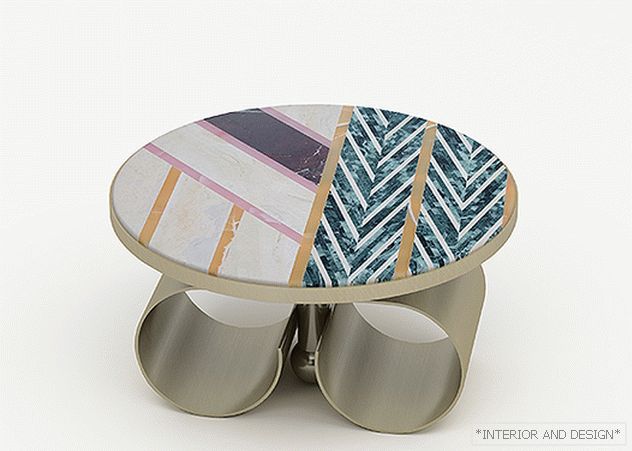 Low table of call. The Happy Room. The diameter is 50 cm. The base is made of brass, the tabletop is made of travertine, inlaid with marble and onyx based on the motifs of the art panels and the Fendi coat.
Low table of call. The Happy Room. The diameter is 50 cm. The base is made of brass, the tabletop is made of travertine, inlaid with marble and onyx based on the motifs of the art panels and the Fendi coat. 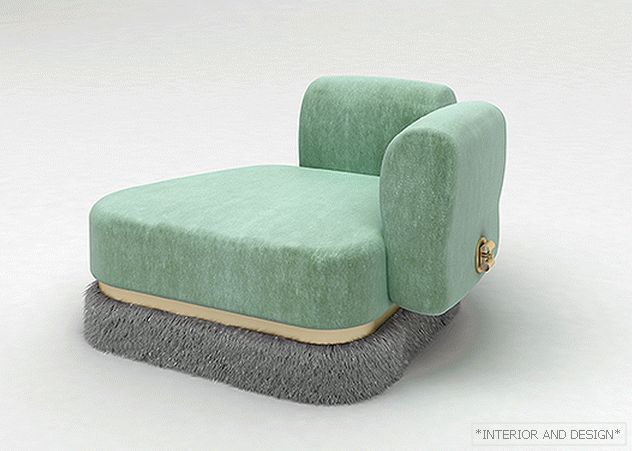 Chair, call. The Happy Room. It is studded with a mint-green Rubelli velvet, the base is trimmed with gray fox fur. On the back of the brass clasp in the form of earrings-stud.
Chair, call. The Happy Room. It is studded with a mint-green Rubelli velvet, the base is trimmed with gray fox fur. On the back of the brass clasp in the form of earrings-stud.  Sofa, call. The Happy Room. It is upholstered in velvet Rubelli of mustard color, the base is trimmed with gray fox fur. On the back of the brass clasps in the form of earrings, studs.
Sofa, call. The Happy Room. It is upholstered in velvet Rubelli of mustard color, the base is trimmed with gray fox fur. On the back of the brass clasps in the form of earrings, studs. Fendi has been working with Design Miami / Basel since 2008, sponsoring the forum and organizing various special projects with the participation of both young and promising and already well-known designers. In 2008, with the support of the brand, discussions with famous designers Fernando and Umberto Campana, Arik Levy, Tom Dixon, Julia Loman, Ross Lovegrove and others were organized at the fair. York art studio Aranda / Lasch, design duets Formafantasma and Dimorestudio, legend of French design Maria Perge. Last year, the installation, presented by Fendi, was devoted to the brand’s new headquarters, which opened in the newly renovated building of 1943, the so-called Italian Civilization Palace (Palazzo della Civiltà Italiana) in the EUR region. Fendi showed a collection of furniture, recreated according to the sketches of the Italian designer of the 1930s, Juliemo Ulrich, and never released before.
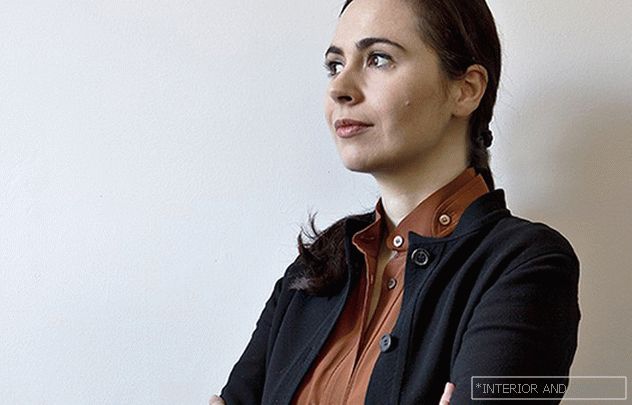 Designer Cristina Celestino (Cristina Celestino).
Designer Cristina Celestino (Cristina Celestino). In 2016, the 36-year-old rising star of Italian design Christina Celestino became a partner of the brand. She received a degree in architecture in Venice, and in 2009 she moved to Milan, where she opened her own studio Attico. Kristina produces the author's things under this brand, and also collaborates with Italian galleries and design factories operating in the limited edition segment. Her hand-made Atomizers stained glass dispensers, created for Seletti, were included in the collection of the Milan Design Museum Triennale. In 2012, her studio was invited to participate in the Salone Satellite as part of Milan Design Week. In 2016, at the Milan Furniture Salon, many paid attention to her collection of ceramic tiles and mosaics Plumage, in which the shape of bird feathers is played up. Christina created her for the factory Bottega Nove, the art director of which she recently became. Other brands for which Kristina works include Atipico, BBBemmebonacina, Durame, Flexform, Antonio Frattini, Ichendorf, Mogg, Tonelli, Torremato.
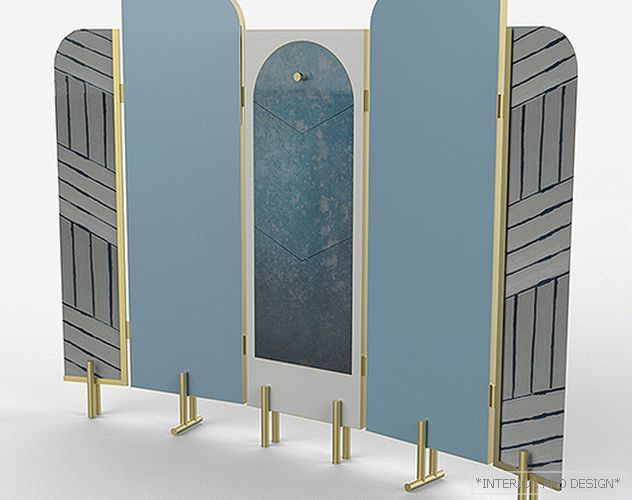 Five-fold cover, call. The Happy Room. Brass, wood. lacquered with a dusty-blue hue, side panels made of fur treated with resin using the Etere technique. Ornament based on the layout of fur in Astuccio coat 1971 by K. Lagerfeld.
Five-fold cover, call. The Happy Room. Brass, wood. lacquered with a dusty-blue hue, side panels made of fur treated with resin using the Etere technique. Ornament based on the layout of fur in Astuccio coat 1971 by K. Lagerfeld. 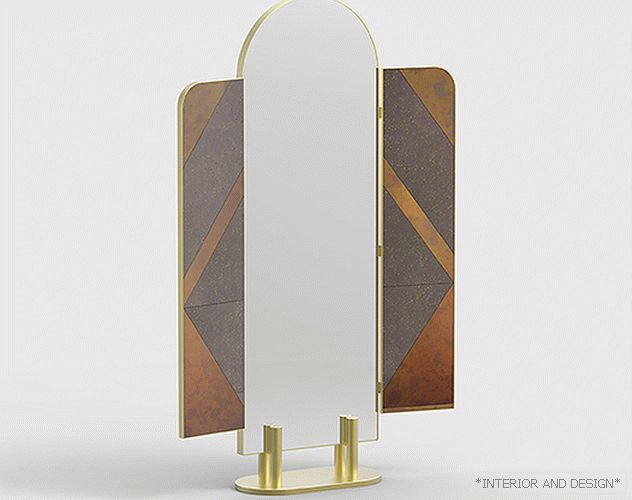 Floor mirror in a frame of brass, repeats the motif of the arch, the side panels of the mirror and metal, covered with a patina.
Floor mirror in a frame of brass, repeats the motif of the arch, the side panels of the mirror and metal, covered with a patina. 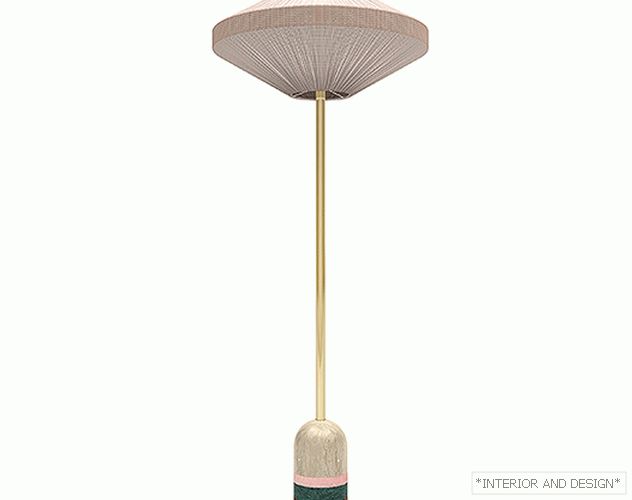 Floor lamp on the basis of travertine and marble, stand of brass, lampshade of perforated calf leather.
Floor lamp on the basis of travertine and marble, stand of brass, lampshade of perforated calf leather. Christina has created a very feminine collection for Fendi, but without too much sentimentality. It captures the elegance and elegance of forms, the subtlety of handwork, nobility and exquisite dressing materials, cozy warm colors. Here you can feel the light breath of Art Deco, and a curtsy to the Italian design of the 1950s. In his interviews, Christina doesn’t hide her enthusiasm for the work of Joe Ponti, Ettore Sottsass, Paolo Buff, their ability to work with the form and materials. In her own home collection of “design icons” there is a Joe Ponti coffee table and a Chiara Mario Bellini lamp.
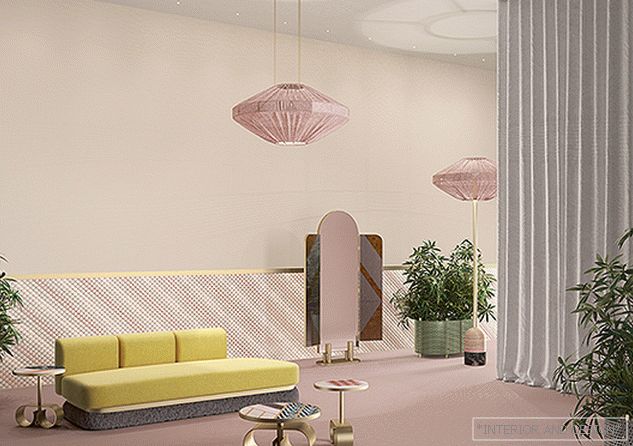 Fendi booth at Design Miami Fair, call. The Happy Room, diz. K. Celestino. On the wall is a mosaic of calls. Plumage for Bottega Nove.
Fendi booth at Design Miami Fair, call. The Happy Room, diz. K. Celestino. On the wall is a mosaic of calls. Plumage for Bottega Nove. But, of course, The Happy Room collection is full of allusions to the products of the most fashionable house of Fendi and reminiscences from its history. Pietro Beccari, executive director of Fendi, stresses that Christina keenly caught the important “cultural codes” of the fashion house. She, for example, used natural fur, a material that glorified the Fendi brand — they trimmed the bases of the sofa and the armchair that were included in the collection. Marble lepanto rosso and travertine, with which the tops of coffee tables are inlaid, is the visiting card of the interiors of many boutiques of the fashion house, including its flagship Roman Palazzo Fendi. The inlay technique itself - just not marble in marble or wood on wood, as in the collection of The Happy Room, but fur on fur is also the signature style of the designers of the fashion house. Another “typical” motive is the arch, referring to the arcades of the Palazzo della Civiltà Italiana, where the headquarters of Fendi is now located.
 Sketch for the collection The Happy Room, K. Celestino for Fendi.
Sketch for the collection The Happy Room, K. Celestino for Fendi. Patterns in the form of arches adorn the top of one of the coffee tables, the floor mirror panels and screens are arched. Especially for the collection Christina came up with the technique of "perpetuating" the fur - it was called Etere. The fur is treated with a transparent resin and hardens in it, like an insect in amber, becomes hard and as if covered with light frost. In this technique, the side panels are made of a five-fold screen, and their pattern repeats the layout of fur in the Astuccio coat, created in 1971 by the cult in the history of fashion. A subject so popular in the history of jewelry as earrings-carnations, in the form of which brass bases of tables and fasteners on the backs of the armchair and sofa are made, simply unobtrusively introduces us to the context of the fashion world.


